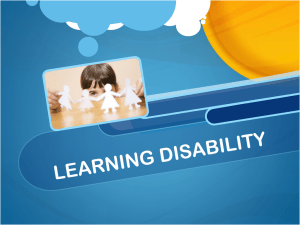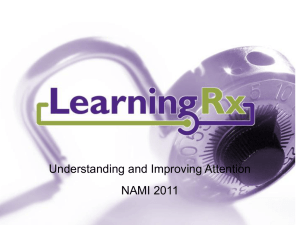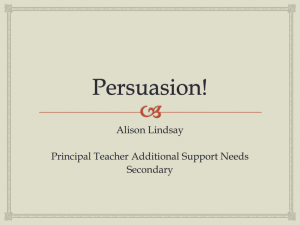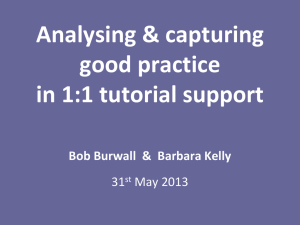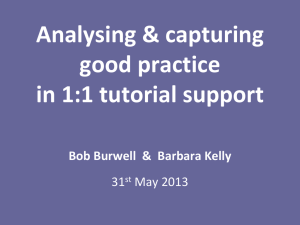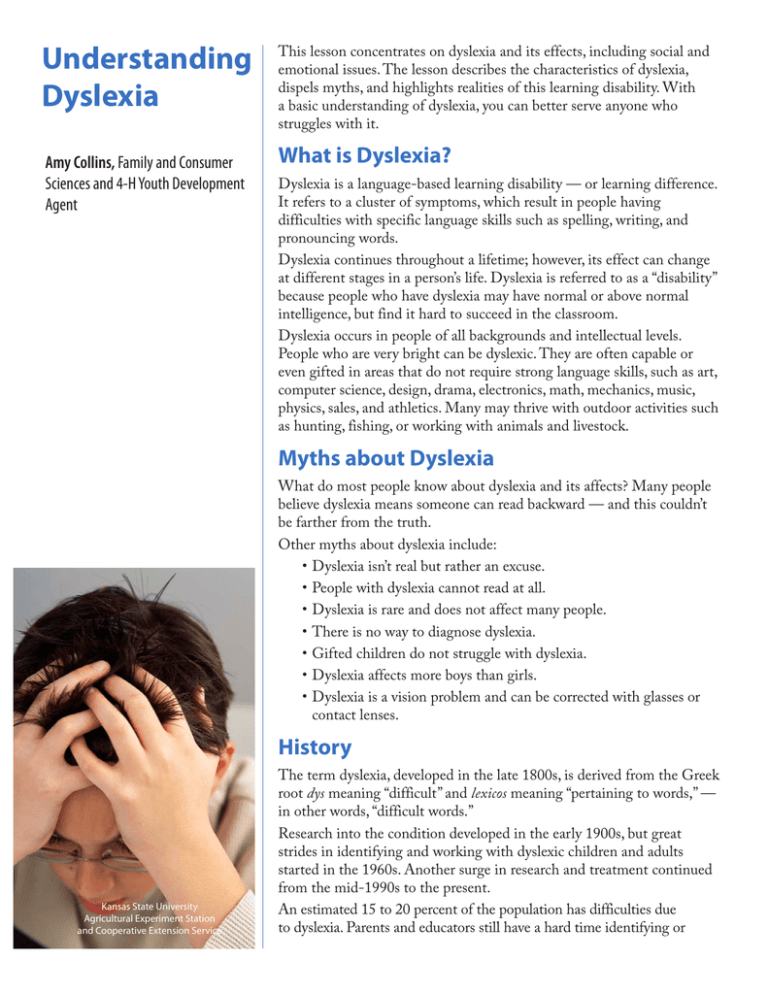
Understanding
Dyslexia
Amy Collins, Family and Consumer
Sciences and 4-H Youth Development
Agent
This lesson concentrates on dyslexia and its effects, including social and
emotional issues. The lesson describes the characteristics of dyslexia,
dispels myths, and highlights realities of this learning disability. With
a basic understanding of dyslexia, you can better serve anyone who
struggles with it.
What is Dyslexia?
Dyslexia is a language-based learning disability — or learning difference.
It refers to a cluster of symptoms, which result in people having
difficulties with specific language skills such as spelling, writing, and
pronouncing words.
Dyslexia continues throughout a lifetime; however, its effect can change
at different stages in a person’s life. Dyslexia is referred to as a “disability”
because people who have dyslexia may have normal or above normal
intelligence, but find it hard to succeed in the classroom.
Dyslexia occurs in people of all backgrounds and intellectual levels.
People who are very bright can be dyslexic. They are often capable or
even gifted in areas that do not require strong language skills, such as art,
computer science, design, drama, electronics, math, mechanics, music,
physics, sales, and athletics. Many may thrive with outdoor activities such
as hunting, fishing, or working with animals and livestock.
Myths about Dyslexia
What do most people know about dyslexia and its affects? Many people
believe dyslexia means someone can read backward — and this couldn’t
be farther from the truth.
Other myths about dyslexia include:
•Dyslexia isn’t real but rather an excuse.
•People with dyslexia cannot read at all.
•Dyslexia is rare and does not affect many people.
•There is no way to diagnose dyslexia.
•Gifted children do not struggle with dyslexia.
•Dyslexia affects more boys than girls.
•Dyslexia is a vision problem and can be corrected with glasses or
contact lenses.
History
Kansas State University
Agricultural Experiment Station
and Cooperative Extension Service
The term dyslexia, developed in the late 1800s, is derived from the Greek
root dys meaning “difficult” and lexicos meaning “pertaining to words,” —
in other words, “difficult words.”
Research into the condition developed in the early 1900s, but great
strides in identifying and working with dyslexic children and adults
started in the 1960s. Another surge in research and treatment continued
from the mid-1990s to the present.
An estimated 15 to 20 percent of the population has difficulties due
to dyslexia. Parents and educators still have a hard time identifying or
Characteristics of Dyslexia
Dyslexia is not related to a lack of intelligence
or desire to learn. Studies show that with
a basic understanding of dyslexia and
appropriate teaching methods, dyslexics
can learn successfully and succeed at almost
anything they try.
There is a good chance that someone who is
dyslexic also struggles with some other types
of learning disabilities.
• Dysgraphia: (dis graf ē a) difficulty with
handwriting.
• Dyscalculia: (dis cal que lē a) difficulty
with math.
• ADHD: difficulty with attention.
(Either inattentive or hyperactive, and
sometimes both, depending on the
individual.)
• Dyspraxia: (dis prax ē a) difficulty with
motor skills.
Common characteristics:
• Difficulty in learning to write the
alphabet correctly in sequence.
• Difficulty in learning and remembering
printed words.
• Reversal of letters or sequences of
letters.
• Difficulty in learning to read.
• Difficulty in reading comprehension.
• Cramped or illegible handwriting.
• Repeated erratic spelling errors.
• Delay in spoken language.
• Problems in learning the names of the
letters of the alphabet.
• Difficulty in finding the “right” word
when speaking.
• May be late in establishing preferred
hand for writing.
• May be late in learning right and left
and other directionality components
such as up/down, front/behind, over/
under, east/west.
understanding dyslexia in children. Therefore, the people who work daily
with kids who struggle with dyslexia find it difficult to connect the dyslexic
differences with the social and emotional problems related to dyslexia.
What Causes Dyslexia?
The exact causes of dyslexia are still not completely clear, but anatomical
and brain imagery studies show differences in the way the brain of a
dyslexic person develops and functions. Dyslexia is caused by biological
factors rather than emotional or family problems.
Because researchers have linked dyslexia to areas of the brain, this
means that dyslexics will not outgrow dyslexia. Dyslexia is both familial
and heritable, which means it runs in families (and sometimes jumps a
generation) and can be inherited.
If someone is diagnosed with dyslexia and enough research is done
within that family, most may find that dyslexia was prominent
throughout past generations despite not quite knowing what it was.
Maybe there was a grandfather who didn’t read very well, or a great
grandmother who struggled with handwriting, or even a cousin who
“wasn’t a very good student.”
How Is Dyslexia Treated?
With proper help, many people with dyslexia can learn to read and write
well. Early identification and treatment is the key to helping dyslexics
achieve in school and in life.
Most people with dyslexia need help from a teacher, tutor, or therapist
trained in using a multisensory, structured language approach, also called
the Orton-Gillingham approach. It is important for these individuals to
be taught by a systematic and explicit method that involves several senses
(hearing, seeing, touching) at the same time. Many individuals with
dyslexia need one-on-one help so they can learn at their own pace.
In addition, students with dyslexia often need a great deal of structured
practice and immediate, corrective feedback to develop automatic word
recognition skills. When students with dyslexia receive academic therapy
outside of school, the therapist should work closely with classroom
teachers, special education providers, and other school personnel.
How Do Dyslexics Learn?
Although learning in a regular classroom environment can be a challenge,
it is not impossible. Research has shown that with the proper teaching
techniques, all but 5 percent of students with reading trouble were taught
to function at grade level.
Dyslexic children learn best by engaging multiple senses — visually
(eyes), audibly (ears), and kinesthetically (muscles). In other words, see it,
hear it, feel it. This is also called V-A-K learning.
Research suggests that 60 percent of children find reading challenging or
extremely difficult. What most people fail to realize is that speaking is a
natural process, but reading is a learned process.
2
Dyslexia is the difference
between a child’s potential
and actual achievement.
Three main indicators seem to affect the chances for success, when a
child has dyslexia:
1. Early in the child’s life, someone has been extremely supportive
and encouraging.
2. The child with dyslexia found an area of interest in which he or she
could succeed.
Is Dyslexia Really a
Problem?
Yes! There are many adults in the world who
have grown up believing “they just weren’t
smart enough” when in reality they really
were. What they didn’t have was the basic
understanding of their learning difference
or the correct tools to work with their
difference.
The earlier a child is evaluated for dyslexia
the sooner help can be provided. Dyslexia is
one of the most researched and documented
conditions that will affect children
throughout their school careers and the rest
of their lives.
Without the proper diagnosis and
accommodations, children will fall through
the cracks in the classroom and the results
will be life altering. Not only will the child
struggle academically, but will also struggle
with self-esteem, the guilt of not meeting
others’ expectations, anxiety, and frustration.
3. Finally, people who have successfully dealt with their dyslexia
appear to have developed a commitment to helping others.
Social and Emotional Effects
The effects of dyslexia reach well beyond the classroom. It can affect a
person’s self-image. Students with
dyslexia often end up feeling “dumb”
and less capable than they are.
After experiencing a great deal of
stress due to academic problems,
students may become so frustrated
they begin to consider school and
learning to be bad experiences. Once
this has happened, it’s difficult to
change their perception of school.
Because students become frustrated,
they may act out in class, become the
class clown, or avoid doing assignments. They would rather be disciplined
for bad behavior than admit they cannot do the work. Often teachers
don’t understand this avoidance behavior and soon the student is labeled
as “lazy,” or “doesn’t try hard enough.” Often parents will hear over and
over again “…he/she is such a bright child; if only he would try harder.”
Ironically, no one knows exactly how hard the dyslexic is trying.
How to Help
Adults working with youth in any capacity — whether it be at church,
through youth groups, 4-H or scout leaders, as coaches, as teachers, as
grandparents, or as volunteers at school — need to understand that not
all children learn in the same way. Assume the role of “educator” in order
to bring out the best in kids affected by dyslexia.
Other suggestions to consider:
•Accept and value creative ideas. To understand what a child learned,
accept an activity or project in lieu of a written report.
•Students should receive multisensory instructions from the adult
that includes:
•demonstrating
•illustrating
•showing
•telling
3
Author
Amy Collins, Family and Consumer Sciences
and 4-H Youth Development Agent, K-State
Research and Extension – Stafford County
Reviewers
Nancy Honig, Director, K-State Research and
Extension – Stevens County
Charles Smith, Child Development Specialist,
K-State Research and Extension, and
Professor, School of Family Studies and
Human Services, Kansas State University
•Don’t make them memorize words or facts. Because kids with
dyslexia have poor short-term memory, memorization is ineffective,
especially for spelling tests or other rote memorization tasks.
•Don’t assume they will want to read aloud. As volunteers, you have
no way of knowing which kids are comfortable with reading out
loud and which kids are not. This could be a deal breaker for some,
and the reason they won’t want to come back next time.
•Set them up for success: Quick, short lessons help the dyslexic
learner process the information being taught. Brief review of the
information will ensure that he or she will retain it.
•Behavior should be acceptable if it doesn’t interfere with another
student’s learning. Some kids simply learn better when they are
allowed to stand up and listen, or sit on the floor. Other kids learn
better if they are allowed to doodle or gaze out the window.
•When the child does exhibit unacceptable behavior, adults must not
inadvertently discourage the dyslexic child. Avoid words such “lazy,”
“stupid,” or “troublemaker.” Calmly pull the child aside and explain
that the behavior is unacceptable. Then, explain your expectations
and how you would like the child to behave — sometimes he or she
just didn’t know.
•Do not punish a child by taking away recess or another fun activity.
More often than not, this is the outlet kids need to expend energy
and recharge.
•Help children feel good about who they are. They should leave
school, youth group, or a sports activity feeling they were successful
with something. Praise and encourage them as often as possible.
•Teachers, parents, volunteers, and mentors need to offer consistent,
ongoing encouragement and support. Be sure to listen to children’s
feelings. Anxiety, anger, and depression are all daily companions for
dyslexics. However, their language problems often make it difficult
for them to express how or what they are feeling. Adults must be
patient and help them learn to talk about their feelings.
•Encourage reading. Despite having trouble reading, children
with dyslexia may still enjoy the story in a book. Read out loud
to kids, even older kids. Continue to foster their interest in books
by allowing them to listen to books on tape, CD, or on their mp3
players or e-readers.
Brand names appearing in this publication are for product identification purposes only.
No endorsement is intended, nor is criticism implied of similar products not mentioned.
Publications from Kansas State University are available at: www.ksre.ksu.edu
Publications are reviewed or revised annually by appropriate faculty to reflect current research and practice.
Date shown is that of publication or last revision. Contents of this publication may be freely reproduced for
educational purposes. All other rights reserved. In each case, credit Amy Collins,
Understanding Dyslexia, Fact Sheet, Kansas State University, August 2011.
Kansas State University Agricultural Experiment Station and Cooperative Extension Service
MF2987
August 2011
K-State Research and Extension is an equal opportunity provider and employer. Issued in furtherance of Cooperative Extension Work, Acts of May 8 and June 30, 1914,
as amended. Kansas State University, County Extension Councils, Extension Districts, and United States Department of Agriculture Cooperating, Gary Pierzynski, Interim
Director.


